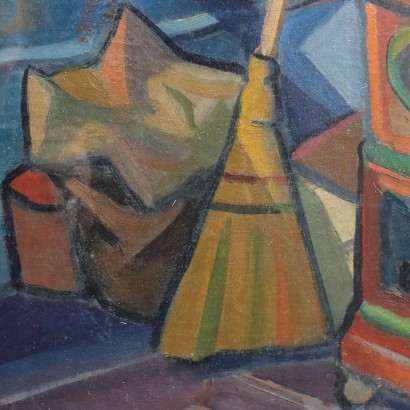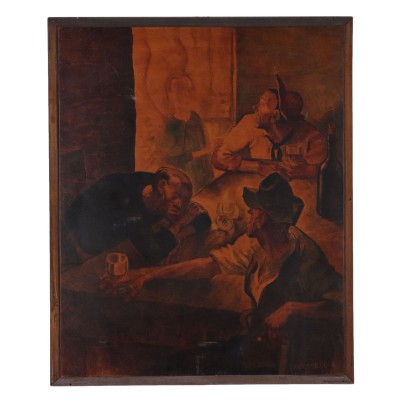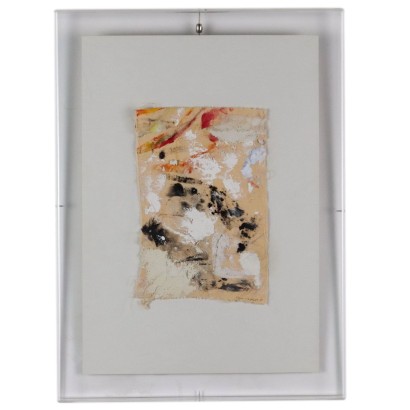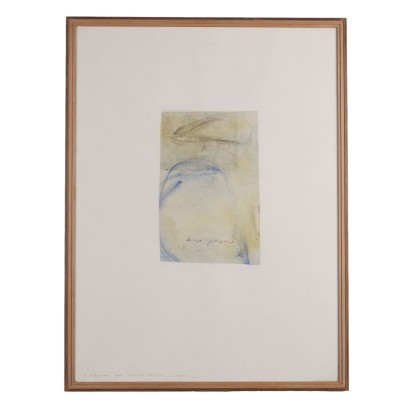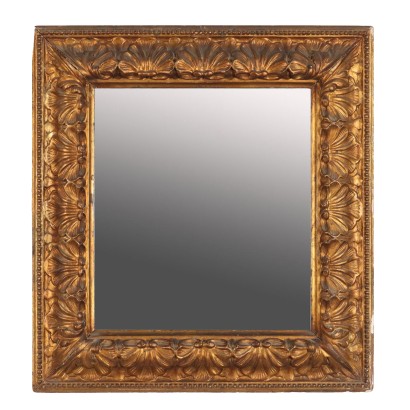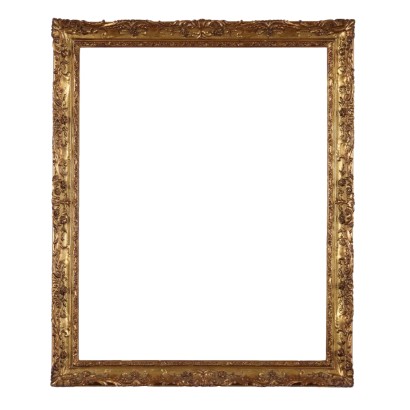Contemporary Painting Alvaro Monnini Oil on Canvas 1946 - Interior with Stove 1946
Features
Interior with Stove 1946
Artist: Alvaro Monnini (1922-1987)
Artwork title: Interno con stufa
Age: 20th Century / 1901 - 2000
Subject: Glimpse of interior
Artistic technique: Painting
Technical specification: Oil on Canvas
Description : Interno con stufa
Oil on canvas. Signed and dated lower right. The work belongs to the first period of the Florentine artist, still close to the figurative before dedicating himself definitively to Abstractionism, in particular to classical Abstractionism, of whose Manifesto of 1950 he was one of the signatories. The work is influenced by post-cubism, in the representation of a figurative subject, not broken down as in cubism, but highlighted and emphasized in simple geometric lines, variously composed, in intersection, oriented in various ways, which refer to recognizable objects but depicted not as copies of reality but as formal concepts. The work is presented in a frame.
Product Condition:
Product in good condition, shows small signs of wear. We try to present the real condition as completely as possible with the photos. If some details are not clear from the photos, what is reported in the description is valid.
Frame Size (cm):
Height: 74
Width: 64
Depth: 4
Artwork dimensions (cm):
Height: 60
Width: 50
Additional Information
Artist: Alvaro Monnini (1922-1987)
Born in Florence in 1922, Alvaro Monnini, after an initial figurative training, approached post-cubism, to then arrive at abstractionism, in particular the current of Classical Abstractionism, which was born with the Gruppo Arte d'Oggi in Florence, in 1947. Monnini is one of the signatories of the Manifesto of Classical Abstractionism, drawn up by Ermanno Migliorini in 1950, together with V. Berti, B. Brunetti, G. Nativi. In 1951 he held his first solo exhibition at the Galleria Numero; These are years in which his work proceeds autonomously and more detached from the activity of the group that, with the exclusion from the Venice Biennale, concludes the experience of Arte d'Oggi by signing the declaration End of Classical Abstractionism in 1950. Monnini works in isolation until 1955: applying artistic research to the various creations of the artisanal field (from ceramics to fabrics) he begins with his wife, Nicol de Palma, a collaboration with the fashion atelier of the Florentine stylist Emilio Pucci and continues to develop his painting independently. Since 1963 he has lived and worked in Milan, where he approaches informal artistic experiences. In the Seventies, his work culminates in an artistic genre defined as abstract-surreal, based on a language of evocative forms, of which the maximum example is the 1970 exhibition entitled I Demoni at the Galleria Shubert in Milan. Since 1979 he has been a professor of Theory of Form, Theory of Color and Descriptive Geometries at the Istituto Politecnico Internazionale – Centro superiore di Architettura e Design – in Milan. During this period the artist is particularly interested in design and architecture, and creates coordinated wall and floor coverings and a set-up for a meeting room at Snam Progetti in Assago, Milan. The 1980s conclude his artistic career, which now turns towards a sort of “return to the origins”, that is, a rediscovery of order and geometric rigor that develops in a changing space: these are constructions of solids that change appearance depending on the point of view and how they are perceived by the spectator. Monnini died in Milan in 1987.Age: 20th Century / 1901 - 2000
20th Century / 1901 - 2000Subject: Glimpse of interior
Artistic technique: Painting
La pittura è l'arte che consiste nell'applicare dei pigmenti a un supporto come la carta, la tela, la seta, la ceramica, il legno, il vetro o un muro. Essendo i pigmenti essenzialmente solidi, è necessario utilizzare un legante, che li porti a uno stadio liquido, più fluido o più denso, e un collante, che permetta l'adesione duratura al supporto. Chi dipinge è detto pittore o pittrice. Il risultato è un'immagine che, a seconda delle intenzioni dell'autore, esprime la sua percezione del mondo o una libera associazione di forme o un qualsiasi altro significato, a seconda della sua creatività, del suo gusto estetico e di quello della società di cui fa parte.Technical specification: Oil on Canvas
The oil painting is a painting technique using powder pigments mixed with bases in inert and oils.Other customers have searched:
Arte Contemporanea, tecnica mista, composizione astratta, arte novecento, arte contemporanea, arte astratta, pittori italiani quadri olio su tela paesaggi..
Se sei un appassionato d'arte, non perderti i nostri approfondimenti sul Blog Arte Di Mano in Mano e su FineArt by Di Mano in Mano - Arte:
Leggi di più
Ecco alcuni tra i principali articoli:
Vedute
Falsi nell'arte antica
Un messaggio di fiducia per ripartire
La potenza espressiva dell'arte figurativa etiope
Breve Storia del Collezionismo
Giorgio Upiglio, maestro dei libri d'artista
Matthias Withoos detto "Calzetta bianca"
San Rocco pensaci tu - Classic Monday
Sapevi che l'arte può essere anche un ottimo investimento (e non solo per grandi portafogli)?
L'Arte tra Collezionismo e Investimento
FineArt: Arte come investimento
Dai un'occhiata alle nostre rubriche di divulgazione sull'arte:
Epoche
Lavorazioni e tecniche
Mostre ed Eventi
Protagonisti
Leggi di più
Ecco alcuni tra i principali articoli:Vedute
Falsi nell'arte antica
Un messaggio di fiducia per ripartire
La potenza espressiva dell'arte figurativa etiope
Breve Storia del Collezionismo
Giorgio Upiglio, maestro dei libri d'artista
Matthias Withoos detto "Calzetta bianca"
San Rocco pensaci tu - Classic Monday
Sapevi che l'arte può essere anche un ottimo investimento (e non solo per grandi portafogli)?
L'Arte tra Collezionismo e Investimento
FineArt: Arte come investimento
Dai un'occhiata alle nostre rubriche di divulgazione sull'arte:
Epoche
Lavorazioni e tecniche
Mostre ed Eventi
Protagonisti






